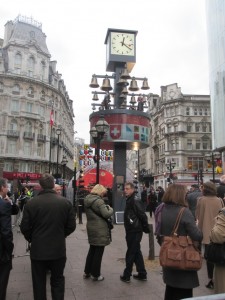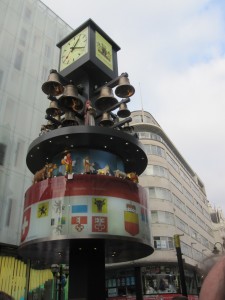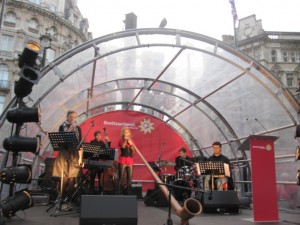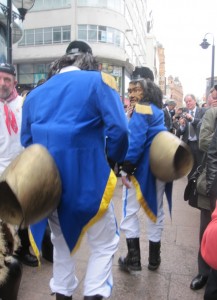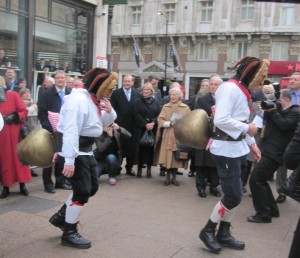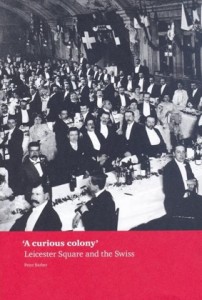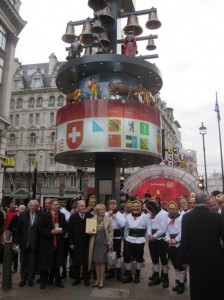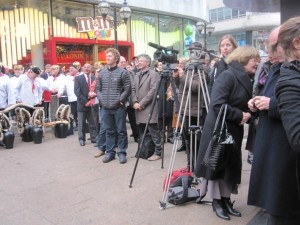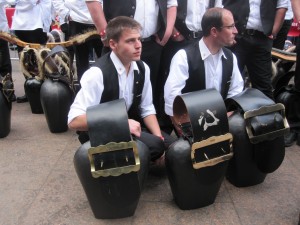OC 41: Place and Identity
The bells are back
27 of them; on The reinstated Glockenspiel in Swiss Court, central London. Crowned by an astronomical clock, repaired and electronically enhanced they accompany the movements of cows and their keepers to the amusement of bystanders. The Glockenspiel was first installed as a symbol of friendship between the Swiss colony in central London and the City of Westminster. It had disappeared with the Swiss centre in Leicester Square, leaving behind nothing but a Street named ‘Swiss Court’, no longer populated by Swiss cafes but earmarked for the Glockenspiel’s return.
Meaning?
What does the revival of this Glockenspiel signify? Originally used as medieval means of communication from town halls, clock towers, cathedrals and civic memorials Glockenspiels have great pulling power. Situated next to the “tree of Swiss canton coats of arms” the restored Glockenspiel plays music composed jointly by the Royal Academy of Music in Westminster and the Academy of Music and Art in Berne. On the day of its return its bells were played live from a modern keyboard accompanied by Swiss musicians with folkloric instruments.
Bell playing folklore groups joined the performance, some with masks originating in an ancient carnival license for anonymous free speech, others wearing uniforms dating back to Swiss mercenaries in Napoleonic wars.
Reinstated identity
Reinstated at great expense , the Glockenspiel is contributing to the identity of Swiss Court as a memorial to three hundred years of Swiss immigration. Sometimes intermarried and knighted, the Swiss immigrants ranged from honorary envoys to the British court, cartographers, art connoisseurs and tutors of the British aristocracy, to highly skilled artisans who produced stucco in royal palaces. They were joined later by the more modest catering professions who brought about vaudeville, made ice, generated electricity and introduced new foods to what they turned into theatre-land. This symbiosis between Swiss immigrants who kept their nationality on the whole and their host country should have made for a cosmopolitan brew, enriching it by yet another outside culture.
However, fast growing London diffused minority colonies to the suburbs. According to Peter Barber’s “A Curious Colony, Leicester Square and the Swiss” (2011, Jannuzi Smith Publications) the demise of the Swiss centre was due, at least in parts, to the redundant need of different nationalities to affirm themselves as an entity in their host countries. Even bidding for tourism had migrated to the internet, displacing expensive national shop windows.
Role of cultural symbol?
Will the new Glockenspiel simply become a symbol of archaeological spatial memory or could it trigger a revival of spatial identity for specific groups in a globalising world, akin to the Chinese next door who produce lavish Chinese new year spectacles? Is it by chance that the mayors of London invited various ethnic minorities settled in London to celebrate their festivals in neighbouring Trafalgar Square, a place which has a history of attracting encounters between diverse groups, some confrontational, some seeking communal celebrations?
Role of space?
Now as then, open spaces matter in cities. Public space is defined by who lays claims to it, who is using it, for what purpose; conversely the identity of the users of the public realm are defining and continuously changing cities. Leicester Square is being dug up yet again, with a new destiny for future use. How will that affect Swiss Court and its new Glockenspiel? What identity will it adopt, now that the official deeds are done?
Legacy
What legacy of the Swiss colony will remain and how will the Swiss of long standing as well as those who continue to migrate to London contribute to it and transform it to suit new purposes?
The Swiss centre site has been taken over by an American W hotel with an opaque façade and no ground floor activities towards Swiss Court, safe for a narrow entrance to privately owned indoor entertainment. Life in Swiss Court will have to come from other sources.
It will be interesting to observe how it is being used when the weather is getting clement again and what role the Glockenspiel may play in this.

